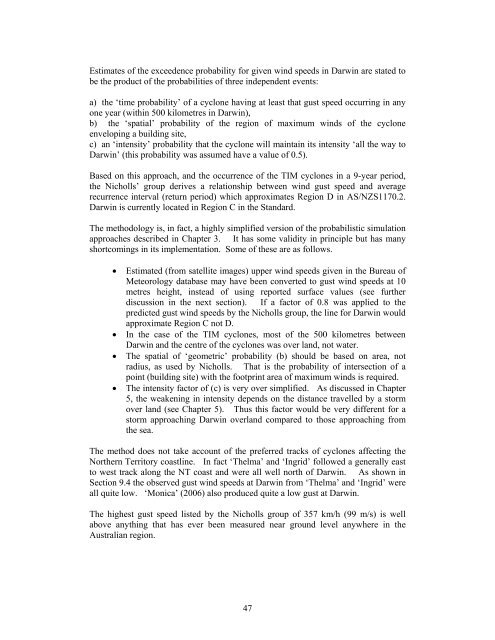PDF | 2 MB - Australian Building Codes Board
PDF | 2 MB - Australian Building Codes Board
PDF | 2 MB - Australian Building Codes Board
You also want an ePaper? Increase the reach of your titles
YUMPU automatically turns print PDFs into web optimized ePapers that Google loves.
Estimates of the exceedence probability for given wind speeds in Darwin are stated to<br />
be the product of the probabilities of three independent events:<br />
a) the ‘time probability’ of a cyclone having at least that gust speed occurring in any<br />
one year (within 500 kilometres in Darwin), <br />
b) the ‘spatial’ probability of the region of maximum winds of the cyclone<br />
enveloping a building site, <br />
c) an ‘intensity’ probability that the cyclone will maintain its intensity ‘all the way to<br />
Darwin’ (this probability was assumed have a value of 0.5). <br />
Based on this approach, and the occurrence of the TIM cyclones in a 9-year period,<br />
the Nicholls’ group derives a relationship between wind gust speed and average<br />
recurrence interval (return period) which approximates Region D in AS/NZS1170.2.<br />
Darwin is currently located in Region C in the Standard.<br />
The methodology is, in fact, a highly simplified version of the probabilistic simulation<br />
approaches described in Chapter 3. It has some validity in principle but has many<br />
shortcomings in its implementation. Some of these are as follows.<br />
• Estimated (from satellite images) upper wind speeds given in the Bureau of<br />
Meteorology database may have been converted to gust wind speeds at 10<br />
metres height, instead of using reported surface values (see further<br />
discussion in the next section). If a factor of 0.8 was applied to the<br />
predicted gust wind speeds by the Nicholls group, the line for Darwin would<br />
approximate Region C not D.<br />
• In the case of the TIM cyclones, most of the 500 kilometres between<br />
Darwin and the centre of the cyclones was over land, not water.<br />
• The spatial of ‘geometric’ probability (b) should be based on area, not<br />
radius, as used by Nicholls. That is the probability of intersection of a<br />
point (building site) with the footprint area of maximum winds is required.<br />
• The intensity factor of (c) is very over simplified. As discussed in Chapter<br />
5, the weakening in intensity depends on the distance travelled by a storm<br />
over land (see Chapter 5). Thus this factor would be very different for a<br />
storm approaching Darwin overland compared to those approaching from<br />
the sea.<br />
The method does not take account of the preferred tracks of cyclones affecting the<br />
Northern Territory coastline. In fact ‘Thelma’ and ‘Ingrid’ followed a generally east<br />
to west track along the NT coast and were all well north of Darwin. As shown in<br />
Section 9.4 the observed gust wind speeds at Darwin from ‘Thelma’ and ‘Ingrid’ were<br />
all quite low. ‘Monica’ (2006) also produced quite a low gust at Darwin.<br />
The highest gust speed listed by the Nicholls group of 357 km/h (99 m/s) is well<br />
above anything that has ever been measured near ground level anywhere in the<br />
<strong>Australian</strong> region.<br />
47
















